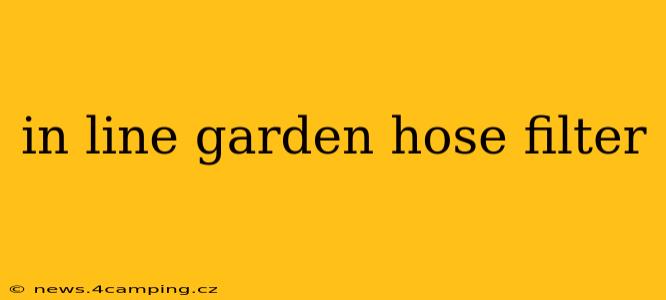Maintaining a healthy lawn and garden requires clean water, and that's where in-line garden hose filters come in. These unsung heroes prevent sediment, debris, and other impurities from clogging your sprinkler system and damaging delicate plants. This comprehensive guide will explore everything you need to know about in-line garden hose filters, helping you choose the right one for your needs.
What is an In-Line Garden Hose Filter?
An in-line garden hose filter is a device installed directly in your garden hose line. It acts as a barrier, trapping sediment, rust, algae, and other particles before they reach your plants or sprinkler heads. This prevents clogging, ensures even water distribution, and protects your valuable irrigation equipment from damage. They are typically compact and easy to install, making them a convenient addition to any watering system.
How Does an In-Line Garden Hose Filter Work?
These filters operate on a simple principle: water flows through a mesh screen or filter element, which traps larger particles. The filtered water then continues to your sprinklers or soaker hoses. The trapped debris is collected within the filter housing, which can be easily cleaned or replaced depending on the filter type.
What are the Benefits of Using an In-Line Garden Hose Filter?
The benefits of using an in-line garden hose filter extend beyond simply cleaner water:
- Prolonged Lifespan of Irrigation Equipment: Prevents clogging and damage to sprinkler heads, valves, and other components.
- Improved Water Distribution: Ensures consistent water flow for even watering and healthier plants.
- Protection of Delicate Plants: Prevents damage to seedlings and sensitive plants from debris or contaminants.
- Cleaner Water for Drinking (with appropriate filters): Some higher-end models are suitable for pre-filtering water intended for human consumption (always check the filter's specifications before using it for this purpose).
- Increased Efficiency: Prevents blockages that can reduce water pressure and waste water.
What Types of In-Line Garden Hose Filters are Available?
Several types of in-line garden hose filters exist, each with its own advantages and disadvantages:
- Mesh Filters: These are the most common type, using a fine mesh screen to trap particles. They're generally affordable and easy to clean.
- Screen Filters: Similar to mesh filters but often with a coarser screen, these are better suited for removing larger debris.
- Disc Filters: These filters utilize replaceable discs to trap sediment. They're often more efficient at removing smaller particles but require replacing the discs periodically.
- Sediment Filters: These are designed specifically to remove fine sediment and silt from the water.
How to Choose the Right In-Line Garden Hose Filter?
Selecting the right filter depends on several factors:
- Water Source: The quality of your water source will dictate the level of filtration needed. If you have well water with high sediment content, a more robust filter may be required.
- Irrigation System: The size and type of your irrigation system will determine the flow rate and filter capacity required.
- Filter Capacity: This refers to the amount of debris the filter can hold before needing cleaning or replacement. Consider the size of your garden and how frequently you water.
- Filter Material: Choose a filter material that is durable and resistant to corrosion.
How Often Should I Clean or Replace My In-Line Garden Hose Filter?
The frequency of cleaning or replacement depends on the filter type, water quality, and usage. Check your filter regularly and clean or replace it as needed. Some filters have a clear housing allowing you to visually inspect the level of accumulated debris. As a general guideline, you may need to clean or replace your filter every few weeks to several months.
Can I Use an In-Line Garden Hose Filter for Drinking Water?
While some high-end in-line filters might claim suitability for pre-filtering drinking water, it's crucial to carefully check the manufacturer's specifications. Many filters are not designed for this purpose and may not effectively remove all harmful contaminants. Always prioritize using a filter specifically certified for drinking water if you intend to use it for this purpose. Using an inappropriate filter could pose health risks.
How to Install an In-Line Garden Hose Filter?
Installation is generally straightforward. Most filters simply connect to your hose using standard garden hose connectors. Consult the manufacturer's instructions for specific installation guidance. Ensure all connections are tight and secure to prevent leaks.
By understanding the various types and benefits of in-line garden hose filters, you can make an informed decision to protect your irrigation system and ensure a thriving garden. Remember to choose a filter that suits your specific needs and maintain it regularly for optimal performance.
